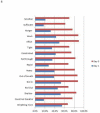Validation of a three-factor measurement model of dyspnea in hospitalized adults with heart failure
- PMID: 21794918
- PMCID: PMC3204315
- DOI: 10.1016/j.hrtlng.2011.05.003
Validation of a three-factor measurement model of dyspnea in hospitalized adults with heart failure
Abstract
Objective: The purpose of this study was to validate a 3-factor measurement model of dyspnea sensory quality (WORK-EFFORT, TIGHTNESS, SMOTHERING-AIR HUNGER) originally derived in patients with exacerbated chronic obstructive pulmonary disease.
Methods: In this validation study, adult patients with heart failure were enrolled after hospital admission (median hospital day 1) and asked to rate the intensity of dyspnea sensory quality descriptors on the day of enrollment (study day 1; N = 119) and in a recall version for the day of admission (study day 0; n = 97).
Results: Confirmatory factor analysis demonstrated good model fit for both days. Cronbach's α for each factor was greater than .87 for both study days.
Conclusion: This is the first study to validate a previously specified measurement model of dyspnea sensory quality in an independent sample. Results indicate that measurement of dyspnea sensory quality in exacerbated cardiopulmonary disease does not necessarily require disease-specific questionnaires.
Copyright © 2012 Elsevier Inc. All rights reserved.
Figures






References
-
- Janson-Bjerklie S, Carrieri VK, Hudes M. The sensations of pulmonary dyspnea. Nurs Res. 1986;35(3):154–159. - PubMed
-
- Harver A, Baird JC, McGovern JF, Daubenspeck JA. Grouping and multidimensional organization of respiratory sensations. Percept Psychophys. 1988;44(3):285–292. - PubMed
-
- Simon PM, Schwartzstein RM, Weiss JW, et al. Distinguishable sensations of breathlessness induced in normal volunteers. Am Rev Respir Dis. 1989;140(4):1021–1027. - PubMed
-
- Simon PM, Schwartzstein RM, Weiss JW, Fencl V, Teghtsoonian M, Weinberger SE. Distinguishable types of dyspnea in patients with shortness of breath. Am Rev Respir Dis. 1990;142(5):1009–1014. - PubMed

